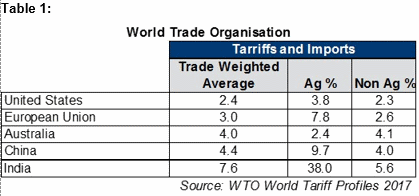Recently, the American President has suggested increasing US steel and US aluminium import tariffs. He has also suggested increasing other US tariffs to mirror the same levels as other competing countries. To discuss this, we look at information on import tariff levels in different countries provided by the World Trade Organisation (WTO). The WTO is an international organisation that regulates international trade.
The WTO came into being on 1 January 1995 with 123 member countries. The WTO now has 164 member countries and 23 extra countries with observer status. China joined in 2001 but only after 15 years of negotiations.
Hong Kong has been a member since 1995 and Taiwan became a member in 2002. It turns out that WTO members do not have to be just countries. They can also qualify if they are a customs territory with full autonomy in the conduct of their external commercial relations. WTO members represent more than 96% of global trade.
Advertisement
As well as memberships for all its individual countries, the European Union demanded a membership for itself (but they would, wouldn't they). Iran is not a member of the WTO. The Holy See is an observer, not a member.
Like many international organisations, the WTO is based in Switzerland. It has over 600 people in Geneva (which I am told is a nice place to have lunch). The WTO regulates the international trade in goods, services and intellectual property. This regulation is aimed at the enforcement of WTO agreements previously agreed by the members. The members of the WTO agree to allow Most Favoured Nation (MFN) status to other members. (Exceptions also allow for preferential treatment of developing countries, regional free trade areas and customs unions.)
In Table 1 below we see the trade weighted average tariff levels granted by some important members of the WTO to other members of the WTO under MFN status.

The members shown in Table 1 are the United States, the European Union, Australia, China and India.
These tariff levels are interesting given the poorly informed debate that has recently occurred about President Trump and import tariffs on steel and aluminium.
Advertisement
It is important to note that the US has the lowest level of tariffs of any of the countries or members in the table.
The US trade weighted average tariff is LOWER than that of the European Union. It is important to know, because of the way the European Commission President, Jean-Claude Juncker, has been pontificating (sorry Pope Francis) about what revenge he will take on the US by increasing EU tariffs.
Juncker speaks with such rectitude, you can almost convince yourself he is sincere and genuine. The EU has a higher weighted average tariff level, primarily because of higher tariffs on imported agricultural products. This is caused by the Common Agricultural Policy, which supports the price of European agricultural products. The Common Agricultural Policy, mostly came into existence in 1962 to stop the French national character from being besmirched, by eating imported food and drinking imported wine.
This article was first published by Morgans.
The information contained in this report is provided to you by Morgans Financial Limited as general advice only, and is made without consideration of an individual's relevant personal circumstances. Morgans Financial Limited ABN 49 010 669 726, its related bodies corporate, directors and officers, employees, authorised representatives and agents ("Morgans") do not accept any liability for any loss or damage arising from or in connection with any action taken or not taken on the basis of information contained in this report, or for any errors or omissions contained within. It is recommended that any persons who wish to act upon this report consult with their Morgans investment adviser before doing so. Those acting upon such information without advice do so entirely at their own risk.
This report was prepared as private communication to clients of Morgans and is not intended for public circulation, publication or for use by any third party. The contents of this report may not be reproduced in whole or in part without the prior written consent of Morgans. While this report is based on information from sources which Morgans believes are reliable, its accuracy and completeness cannot be guaranteed. Any opinions expressed reflect Morgans judgement at this date and are subject to change. Morgans is under no obligation to provide revised assessments in the event of changed circumstances. This report does not constitute an offer or invitation to purchase any securities and should not be relied upon in connection with any contract or commitment whatsoever.
Discuss in our Forums
See what other readers are saying about this article!
Click here to read & post comments.
7 posts so far.